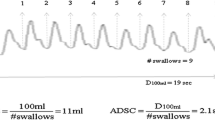Abstract
We investigated the oral and pharyngeal swallowing function in seven Parkinson’s disease (PD) patients, using videomanofluorometry, which is videofluorographic and manometric evaluation conducted simultaneously. Abnormal elevations of resting pressure were found at the upper esophageal sphincter (UES) in three of the seven cases, when they were asked to hold a bolus in the mouth and initiate swallowing. One of these three cases showed an abnormal elevation of resting pressure, intermingled with a normal pressure pattern. Since the UES showed complete relaxation in these three cases, it is inappropriate to suppose that irreversible pathophysiological changes at the level of peripheral nerves had occurred. Our results suggested that altered resting pressure resulted from dysfunction at a more central level, such as a lack of dopaminergic stimulation at the supramedullary level causing skeletal muscle rigidity. Since a tonic abnormality of the UES cannot be measured by only videofluorography, both videofluorographic and manometric evaluation will be necessary to assess the pharyngeal phase of swallowing in PD patients.
Similar content being viewed by others
Author information
Authors and Affiliations
Additional information
Received: 14 December 2000 / Accepted: 5 July 2001
Rights and permissions
About this article
Cite this article
Higo, R., Tayama, N., Watanabe, T. et al. Abnormal elevation of resting pressure at the upper esophageal sphincter of Parkinson’s disease patients. European Archives of Oto-Rhino-Laryngology 258, 552–556 (2001). https://doi.org/10.1007/s004050100401
Issue Date:
DOI: https://doi.org/10.1007/s004050100401




